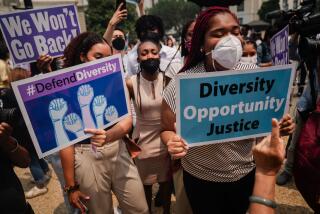No, Brown Isn’t a Bust
The 50th anniversary of Brown vs. Board of Education: Let’s take a moment to celebrate. Not many in the media or the academy are doing so. In fact, the anniversary has become an occasion, it seems, for national mourning. Looking back five decades, many see a time of naive hope. Progress has actually been minimal, it’s said.
Washington Post columnist Colbert King, for instance, argues that the “effect” of today’s racial separation in schools “is much the same” as it was in 1954, “with the same consequence.” Philadelphia’s education chief, Paul Vallas, says, “We’re still wrestling with the same issues.” Harvard Law professor Charles J. Ogletree Jr. has concluded that “50 years after Brown there is little left to celebrate.”
What a dangerously misleading picture.
In fact, 1954 was a very different and terrible time for black children in the segregated schools that the Supreme Court declared unconstitutional. Of course, we have not yet reached the end of the road to real equality. But we have traveled far and have much to be proud of. The chorus of pessimists neglects the basic truth that America has experienced a most remarkable and peaceful revolution in race relations. American apartheid is gone.
Fifty years ago the majority of black Americans lived in the Jim Crow South. One-race schools, separate water fountains, whites-only libraries, restricted seating on buses, the taboo on interracial handshakes -- all were part of an intricate state-sanctioned caste system that exalted the position of whites and rendered unmistakable the subordinate status of blacks.
With Brown, the court began the process of dismantling that system. “To separate [black children] from others of similar age and qualifications solely because of their race generates a feeling of inferior ity.... “ Chief Justice Earl Warren wrote for a unanimous court in Brown.
The specific issue was segregation in public schools, but the point was one that encompassed the entire Jim Crow regime. Hence the rapid impact of Brown on other spheres of public life. Brown said, in effect, that racial inferiority was an idea whose time was up -- although, of course, the justices had no magic wand with which to eliminate racism.
Brown delivered on its most important promise: State-sanctioned segregation came to an end. Today, as a result, the typical black youngster attends a school that is about half black -- an extraordinary change in half a century.
Of course, in many urban districts, whites today are a small minority of the school population. In the Los Angeles Unified School District, for instance, 71% of the students are Latino, while a mere 10% are white. Hence, the charge that American public schools have been “resegregated” and that “the pendulum has swung full circle.”
But those charges are utterly misleading. Children are no longer being assigned to schools on the basis of the color of their skin; segregation is gone. Today, the racial and ethnic mix in the LAUSD, San Francisco and elsewhere reflects demographic reality -- a completely different story. The fact is, the entire school-age population of the city of Los Angeles is only 17.5% white; no amount of social engineering can create majority-white schools.
When we misleadingly label schools in California with few whites “segregated,” the implication is that learning is likely to be compromised. Of course it’s desirable -- where demographically possible -- for children to grow up in a multiracial, multiethnic setting. But surely we don’t want to suggest that the racial mix in a school inevitably determines the quality of the children’s education -- that children in schools without “enough” whites are doomed to academic failure. The doomsayers today who moan about Brown’s failure would have people believe that the problem with urban schools is that they aren’t white enough -- that whites are needed if children are to learn.
Were that the case, American public schools would be in deep and permanent trouble. Superintendents cannot alter the demography of their districts, and Latino immigration is likely to continue. Majority-minority schools in central cities across the nation are inevitable. Only about a third of California’s pupils are white, and whites are a minority of students in Louisiana, Mississippi, New Mexico and Texas as well. By the end of the decade, Arizona, Florida, Nevada and New York will probably join the list. Cities too have changed. White students are down to an average of 16% in central city districts with school populations of 60,000 or more.
But demography is not academic destiny, and the emphasis on “segregation” is a distraction from the real issue: quality education for all public school children. Too many black and Latino children are not acquiring the skills and knowledge they need to do well in life.
Though Brown promised only an end to de jure segregation, the decision inspired larger dreams by referring, in just one sentence, to educational “opportunity ... available to all on equal terms.” That promise, lurking in the shadows of Brown, remains tragically unfulfilled.
“Brown, for all its glory, is something of a bust,” the lead article in the May 17 Newsweek declares. But stressing the unaccomplished carries a high price. Gloom is a self-fulfilling prophecy. It puts a brake on the hard and sustained work that reaching racial equality in education will demand.
We should not kid ourselves and pretend all is well. But, faced with hard tasks ahead, optimists keep going, while pessimists walk away. On the anniversary of Brown, let’s savor how far we’ve come -- as a gift to our future.
More to Read
Sign up for Essential California
The most important California stories and recommendations in your inbox every morning.
You may occasionally receive promotional content from the Los Angeles Times.









